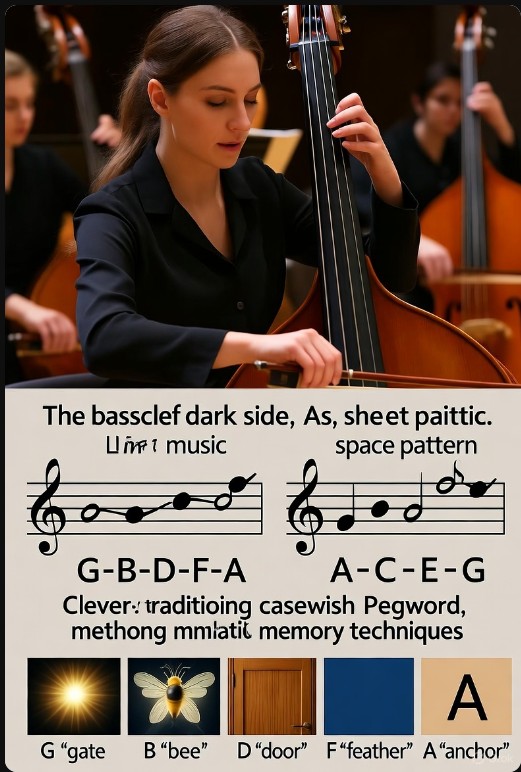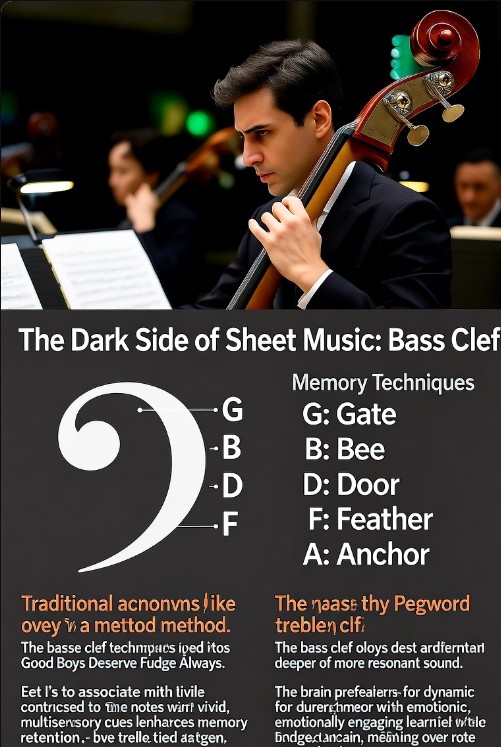
How to Remember Bass Clef Notes: Advanced Mnemonics That Go Beyond the Acronym
Table of Contents
The bass clef may appear as the “dark side” of sheet music, but learning it doesn’t need to be a demanding task. With an understanding of its line pattern (G-B-D-F-A) and space pattern (A-C-E-G), memorization of the bass clef becomes an ability that anyone can learn. The secret lies in learning how to remember bass clef notes with clever and effective techniques beyond the simple bass clef acronym. Even individuals with the highest IQ ever recorded would agree that consistent practice and method are more valuable than natural genius.
Why the Traditional Bass Clef Acronym Fails Most Learners
For decades, musicians have been recalling bass clef notes with such slogans as “Good Boys Deserve Fudge Always” or “Good Burritos Don’t Fall Apart.” These are easy to recite but are based on rote learning alone, which is shallow and forgotten quickly. Learning without deeper meaning is contrary to the way the brain learns and remembers information.
In reality, the brain adores contextual and meaningful patterns. If you have ever asked yourself what color the brain is, it is not only gray; it is a dynamic, vibrant organ that responds most effectively when logic, emotion, and sensory stimulation play off each other.
Compared to the treble clef, which is usually taught first, the bass clef necessitates more deliberate pattern recognition. The main issue with traditional methods is that the bass clef mnemonic is employed as a shortcut instead of a building block. Genuine mastery results when students connect notes with sound, finger movement, and visual perception, making memory a dynamic and long-lasting skill.
Mastering Bass Clef Notes with the Pegword Method

Simple memorization tricks have their limits. A bass clef mnemonic that actually works must involve imagination, senses, and organization. The Pegword method is an old, reliable thinking tool that associates information with vivid mental pictures. Instead of repeating something like “Good Boys Deserve Fudge Always”, you assign each note a specific word or picture that fits into a consistent visual order.
This is how it really works. Each line or space on the musical staff is a “peg” for your memory. Consider, for instance, imagining the note G as a bright “gate,” B as a buzzing “bee,” D as a “door,” F as a “feather,” and A as an “anchor.” Each image finds its particular place on the staff to make a mental topography you can return to at will. This layered connection reinforces memory by means of color, form, and motion—much more effective than rote repetition.
Visual enhancement, or the addition of feeling and sensory detail to images in the mind, makes this system stick. Visualize the anchor glowing under water, or the bee buzzing near the staff lines. When the mind supplies feeling and meaning to an image, memory becomes effortless. That’s the reason why this strategy is better than the simple bass clef notes acronym and other superficial memorization aids.
To test your progress, take a memory test: picture the staff, recall your pictures, and then test them each on paper or an instrument. This brief but useful practice helps you monitor progress and see what notes require more drilling. Lastly, the Pegword tactic translates the challenge of note reading into a constructive and enjoyable mental activity, allowing memory to become an active, as opposed to passive, skill.
From Music Notation to Instrument: Applying Visual Memory
To actually make progress, students must shift from reading symbols on the page to seeing them appear on an instrument. The bass clef is a steady stream of consecutive notes A to G, repeating naturally. When the pattern is memorized, moving it to a physical layout—such as piano keys—is essentially effortless.
Start by visualizing the staff and your memory images for the bass clef. Next, superimpose each mental image onto the keys: visualize the shining “gate” (G) as the lowest G on the piano, the humming “bee” (B) up one step, and the soaring “feather” (F) a few keys higher. By correlating the sound, symbol, and image of the note in one clear sequence, you strengthen memory using multiple senses. This is done by transforming abstract music notation into a concrete and accessible form.
Breaking Free of Rote Learning: The Path to Fluent Sight-Reading
Unlike repetition alone, advanced techniques such as the memory palace and ordered mnemonics train the brain to recall information through association and sense of place. They take you well beyond simple recall; they establish fluency. When you view the staff as an easy-to-follow map rather than a sequence of letters, you’re not just memorizing—you’re understanding.
This technique is applicable to all instruments, from piano to cello, because it works with the same mental processes. Once you know how to remember bass clef notes with systematic visualization, reading becomes second nature. The result is faster sight-reading, better retention, and a more intuitive, self-assured connection with music itself.
Using the advanced bass clef mnemonics or the Pegword method, you connect each note to a distinct mental image or location and are able to recall it more quickly and precisely than simple words.
Yes. Methods like the memory palace and visualization mnemonics engage the pattern-recognizing mechanism of the brain and are therefore effective for piano, cello, bass guitar, and so on.
Through practice and consistent visualization, most students can see significant improvement within a few weeks. Short daily practice sessions and regular tests on memorization accelerate proficiency.